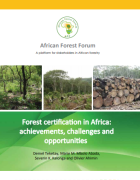Aims of the handbook and how it was compiled
Commissioned by the African Forest Forum (AFF), the general aim of this study was to compile and document, in one publication, the information on FC relevant to Africa scattered in various sources globally, including in the different sub-regions and countries in Africa, as well as review the current status of certification in the different sub-regions of Africa and the continent as a whole. It is hoped, among other things, that this will enhance the understanding of achievements made so far in FC in Africa as well as identifying gaps, challenges, constraints encountered and needs for capacity building, including training programme(s), that will be instrumental in the promotion and successful implementation of FC in Africa.
The specific objectives of the study were to:
briefly review the history of FC as well as assess and document FCS that have made footprints in Africa;
review accreditation and certification bodies and their roles, FC standards and the processes of their development and enabling conditions for FC;
describe how FC is actually implemented in practice and summarize the various contributions of FC;
review the status of FC in Africa through the:
reviewing of past and ongoing support programmes/projects for FC in the sub-regions;
assessment of the current situation of FC in the different countries/sub-regions;
assessment and analyses of the extent and scope of engagement of various national/regional/global FCS in the different countries;
identification of the types and areas of forests certified and/or undergoing the processes of FC;
determining the types and numbers of forest certificates issued and certified forest products and/or services;
investigation of availability, focus and scope of national/sub-regional/international FC standards;
investigation of availability of capacity for FC in the sub-regions;
assessment and documentation of the perceptions of stakeholders on FC and their involvement in and support to the FC processes;
assessment of availability/prospects of markets and market information systems for certified forest products/services from the sub-regions;
documentation of positive and negative lessons learnt;
identification of gaps, challenges and/or constraints of past and ongoing efforts in FC in the sub-regions;
analyses of the strength, weaknesses, opportunities and threats (SWOT) of past and ongoing efforts on FC;
assessment and identification of needs for capacity building for FC in the sub-regions; and,
forward viable/feasible recommendations for promoting FC in the sub-regions in general and AFF engagement in FC in particular.
To achieve these objectives, different methods were employed, including: (i) synthesizing findings and information from studies commissioned by AFF in the eastern and southern, central, northern and western Africa sub-regions; (ii) reviewing and synthesizing relevant information from: (a) published documents (books, periodicals, manuals, scientific journals, reports), (b) unpublished documents, (c) websites of forest certification schemes/systems (FCSs), certified forest companies, countries with certified products as well as those active in FC, organizations offering training on FC and those who were/are active in supporting FC in Africa, and, (d) other internet resources; and, (iii) consultation with experts and authorities responsible for FC and certified forest companies.

